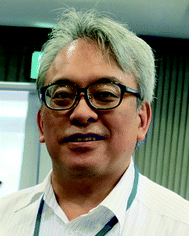Nanoarchitectonics, now
Omar
Azzaroni
a and
Katsuhiko
Ariga
 bc
bc
aInstituto de Investigaciones Fisicoquímicas y Aplicadas (INIFTA), Departamento de Química, Facultad de Ciencias Exactas, Universidad Nacional de La Plata (UNLP) – CONICET, Diagonal 113 y 64 (1900) La Plata, Argentina. E-mail: azzaroni@inifta.unlp.edu.ar
bWPI Research Center for Materials Nanoarchitectonics (MANA), National Institute for Materials Science (NIMS), 1-1 Namiki, Tsukuba, Ibaraki 305-0044, Japan. E-mail: ARIGA.Katsuhiko@nims.go.jp
cGraduate School of Frontier Sciences, The University of Tokyo, 5-1-5 Kashiwanoha, Kashiwa, Chiba 277-8561, Japan
Abstract
Guest Editors Katsuhiko Ariga and Omar Azzaroni introduce this themed collection on soft materials nanoarchitectonics.
Polymers, biomaterials, and soft-matter science not only encompass the world around us but, as a subdiscipline of materials science, they are of ever increasing importance both from the fundamental and applied viewpoints. Explorations in the use of soft materials have significantly expanded our ability to conceive and realize novel functional nanostructures. An important cornerstone for the construction of such functional nanostructures is the development of methods for integrating molecular building blocks into well-defined organized assemblies. Research efforts on this matter are often referred to as “nanoarchitectonics”, a concept originally proposed by Masakazu Aono as a new paradigm based on the arrangement of nanoscale structural components into a predefined configuration that creates a novel functionality through mutual interactions among those units.1–6 The combination of different nanobuilding blocks through multiple interactions opens the door to the construction of hierarchical structures based on spatially organized assemblies of different specific functions in which the interplay between supramolecular and covalent interactions leads to adjustable functions.
Bottom-up nanoscale engineering as a strategy to control materials down to the nanoscale has been on the agenda of scientists and engineers for many years now. Essentially, nanoarchitectonics can be considered as the art of fabricating quantitative amounts of nanoscale systems from designed molecules in which useful ensemble properties and concerted functions emanate directly from organization at different length scales. Indeed, the combination of self-assembly at different length scales offers rich possibilities to construct nanostructured matter displaying switchable and adjustable properties using competing hydrophilic/hydrophobic interactions and complementary physical interactions as molecular driving forces.
Exciting opportunities are revealed when we think in this manner. Nanoarchitectonics provides a complementary perspective from which to consider the molecular design of soft materials with large design flexibility and excellent device integrability. Harnessing the ability to generate localized functional domains with distinct physical properties and chemical environments located in well-defined regions of space represents the basis of the structural and functional control over the formation of nanoarchitected materials. In this way, the molecular design of soft materials from predefined building blocks has been a tremendous success in the past decade. In these research efforts, “nanoarchitectonics” has been employed as a key enabling technology for integrating predefined molecular functionalities, such as electrochemical, optical, catalytic or biological properties, into bulk materials, thin films and devices. In addition, industrial demands on future technologies have created a need for new soft and/or hybrid materials which can only be produced by designing their respective functions and structure at the nanoscale. These features can be typically found and summarized in several review papers in this issue: for example, “Layer-by-layer assembly for photoelectrochemical nanoarchitectonics” by Byeong-Su Kim et al. (DOI: 10.1039/c8me00067k), and “Nanoarchitectonics through supramolecular gelation: formation and switching of diverse nanostructures” by Yutao Sang and Minghua Liu (DOI: 10.1039/c8me00068a).
The concept of nanoarchitectonics has been selected as one of the hot research fronts in RESEARCH FRONTS 2017, reported by Institutes of Science and Development, Chinese Academy of Sciences (CAS), The National Science Library (CAS) and Clarivate Analytics.7 In the records of Web of Science (Dec. 17th, 2018), 119 papers have nanoarchitectonics or nano-architectonics in their titles and 382 papers use these terms as their keywords. These numbers are increasing rapidly.
Nowadays, chemists, engineers and materials scientists are becoming increasingly interested in nanoarchitectonics as a conceptual framework to molecularly design advanced materials from scratch. This explosion of interest is primarily related to the increasing mastery in the design of supramolecular constructs using simple wet chemical approaches. Versatility, flexibility, speed, relative ease of preparation, convenience of scale-up, and economy are the main advantages of the chemical approach to “nanoarchitectonics”. Molecular Systems Design & Engineering (MSDE) is a platform for high quality research into how understanding of molecular properties and interactions can be used to design and assemble better materials and devices with specific functions. In this themed issue you will find a series of articles focused on “soft nanoarchitectonics” in which the rational design of function and structure plays a central role.
References
- K. Ariga, Q. Ji, J. P. Hill, Y. Bando and M. Aono, Forming nanomaterials as layered functional structures towards materials nanoarchitectonics, NPG Asia Mater., 2012, 4, e17 CrossRef.
- K. Ariga, Q. Ji, W. Nakanishi, J. P. Hill and M. Aono, Nanoarchitectonics: a new materials horizon for nanotechnology, Mater. Horiz., 2015, 2, 406 RSC.
- M. Aono and K. Ariga, The way to nanoarchitectonics & the way of nanoarchitectonics, Adv. Mater., 2016, 28, 989 CrossRef CAS PubMed.
- J. M. Giussi, M. L. Cortez, W. A. Marmisollé and O. Azzaroni, Practical use of polymer brushes in sustainable energy applications: interfacial nanoarchitectonics for high-efficiency devices, Chem. Soc. Rev. 10.1039/C8CS00705E.
- A. Lorenzo, W. A. Marmisollé, E. M. Maza, M. Ceolín and O. Azzaroni, Electrochemical nanoarchitectonics through polyaminobenzylamine–dodecyl phosphate complexes: redox activity and mesoscopic organization in self-assembled nanofilms, Phys. Chem. Chem. Phys., 2018, 20, 7570 RSC.
- M. L. Cortez, W. A. Marmisollé, C. von Bilderling, E. Maza, L. Pietrasanta, F. Battaglini, M. Ceolín and O. Azzaroni, Highly-organized stacked multilayers via layer-by-layer assembly of lipid-like surfactants and polyelectrolytes. Stratified supramolecular structures for (bio)electrochemical nanoarchitectonics, Soft Matter, 2018, 14, 1939 RSC.
- https://clarivate.com.cn/research_fronts_2017/2017_research_front_en.pdf .
| This journal is © The Royal Society of Chemistry 2019 |


